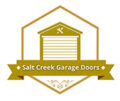Discover easy ways to extend your garage door spring lifespan with these maintenance tips. Contact Salt Creek Garage Doors for expert service in Lincoln, NE.

Why Taking Care of Your Garage Door Springs Matters
Keeping your garage door springs in top shape is easier than you think! Learn simple maintenance tips to avoid costly repairs and extend their lifespan.
When it comes to garage door maintenance, the springs often get overlooked. However, these components are essential for the smooth operation of your door. Whether you need a garage door replacement or just a quick tune-up, taking care of your springs can save you from unexpected repairs and expenses.
Garage door springs bear the weight of the door and facilitate its smooth opening and closing. When neglected, worn-out springs can snap suddenly, leading to potential damage, costly repairs, or even injury. According to industry reports, nearly 20,000 garage door-related injuries occur annually in the U.S. alone. Imagine you’re rushing out to catch a Huskers game at Memorial Stadium, and suddenly, your garage door won’t budge. That’s a scenario no one wants! Proper maintenance helps you avoid such headaches and ensures your garage door operates safely and efficiently.
Simple Maintenance Tips to Extend Garage Door Spring Life
Caring for your garage door springs doesn’t require a lot of effort—just some regular attention. Here are a few easy steps you can take:
1. Regularly Inspect for Wear and Tear Performing routine visual inspections is a crucial first step in maintaining your garage door springs. Check your springs for any visible signs of wear, such as rust, gaps, or fraying. Over time, exposure to moisture and temperature fluctuations can cause corrosion, weakening the metal and leading to premature failure.
Quick Tip: Use a flashlight to inspect hard-to-see areas and always check both torsion and extension springs.
If you notice any damage, consider reaching out for professional garage door spring repair to prevent bigger issues.
2. Lubricate Moving Parts Lubrication is key to reducing friction and extending the lifespan of your garage door springs. Apply a high-quality lubricant, such as a silicone-based or lithium grease, to the springs at least twice a year to keep them flexible and reduce wear and tear. This simple step can prevent squeaking, reduce strain on the motor, and ensure smooth door operation.
Checklist:
- Clean the springs before applying lubricant.
- Use a minimal amount of lubricant to avoid build-up.
- Check rollers and hinges as well.
3. Avoid DIY Adjustments Garage door springs are under a lot of tension and can be extremely dangerous to adjust without the right tools and expertise. Attempting DIY adjustments can result in serious injury or further damage to your garage door system.
Did You Know? A broken spring can carry enough force to cause property damage or severe injury. Always call an expert in garage door repair in Lincoln, NE, if you suspect an issue.
Professionals have the experience and tools necessary to safely handle spring repairs and adjustments.
4. Balance Your Garage Door An unbalanced garage door can put unnecessary strain on the springs and shorten their lifespan. To check the balance, disconnect the opener and manually lift the door halfway. If it stays in place, the springs are in good condition. If it moves up or down, it may be unbalanced and require professional adjustment.
Pro Tip: Unbalanced garage doors can lead to early wear on other parts, such as the tracks and rollers.
5. Schedule Regular Professional Inspections Even if your garage door appears to be functioning well, it’s wise to schedule regular professional inspections. A routine check-up by a professional can catch minor issues before they become major problems. Whether it’s for commercial garage door repair or emergency garage door repair, staying ahead of potential failures is key.
Signs That Your Garage Door Springs Need Repair
Don’t wait until your garage door fails. Look out for these warning signs that your springs may need attention:
- Your garage door opens unevenly or jerks during movement.
- You hear loud creaking, grinding, or snapping noises.
- The door feels heavier than usual when lifting manually.
- The springs appear stretched, elongated or have gaps.
- The garage door closes too quickly or struggles to stay open.
If you notice any of these signs, reach out for a quick garage door spring repair to avoid further damage and ensure continued safe operation.
FAQs About Garage Door Spring Maintenance
How often should I lubricate my garage door springs? It’s best to lubricate your springs every six months to ensure smooth operation. Regular lubrication minimizes friction and prevents early wear and tear.
Can I replace my garage door springs myself? Due to the high tension in the springs, it’s safer to call a professional for garage door installation or spring replacement. DIY replacement can result in injury or damage to your garage door system.
What should I do if my garage door spring breaks? Immediately stop using the door and call Salt Creek Garage Doors for emergency garage door repair. Continuing to use a door with a broken spring can damage other components.
Conclusion
Taking a few simple steps to maintain your garage door springs can make a big difference in their lifespan and performance. Whether you’re dealing with an emergency garage door repair or looking for a new garage door opener repair, proactive maintenance is key to ensuring the reliability and longevity of your garage door system.
At Salt Creek Garage Doors, we’re here to help with all your garage door needs in Lincoln, NE—from garage door installation to regular tune-ups. Whether you live near the Sunken Gardens, stroll through the Historic Haymarket District, or enjoy events at Pinnacle Bank Arena, we’re just a call away!
Contact Salt Creek Garage Doors Today!
Don’t wait until your garage door leaves you stranded. Contact Salt Creek Garage Doors today for expert garage door replacement, residential garage door repair, and more in Lincoln, NE. Our team is dedicated to providing top-notch service and ensuring your garage door operates smoothly for years to come!
